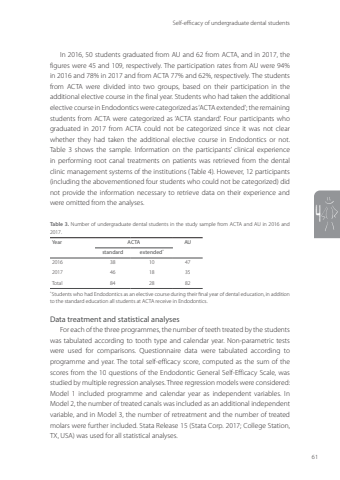Page 63 - Demo
P. 63
Self-efficacy of undergraduate dental students614In 2016, 50 students graduated from AU and 62 from ACTA, and in 2017, the figures were 45 and 109, respectively. The participation rates from AU were 94% in 2016 and 78% in 2017 and from ACTA 77% and 62%, respectively. The students from ACTA were divided into two groups, based on their participation in the additional elective course in the final year. Students who had taken the additional elective course in Endodontics were categorized as ‘ACTA extended’; the remaining students from ACTA were categorized as ‘ACTA standard’. Four participants who graduated in 2017 from ACTA could not be categorized since it was not clear whether they had taken the additional elective course in Endodontics or not. Table 3 shows the sample. Information on the participants’ clinical experience in performing root canal treatments on patients was retrieved from the dental clinic management systems of the institutions (Table 4). However, 12 participants (including the abovementioned four students who could not be categorized) did not provide the information necessary to retrieve data on their experience and were omitted from the analyses.Table 3. Number of undergraduate dental students in the study sample from ACTA and AU in 2016 and 2017. Year ACTA AUstandard extended*2016 38 10 472017 46 18 35Total 84 28 82* Students who had Endodontics as an elective course during their final year of dental education, in addition to the standard education all students at ACTA receive in Endodontics.Data treatment and statistical analysesFor each of the three programmes, the number of teeth treated by the students was tabulated according to tooth type and calendar year. Non-parametric tests were used for comparisons. Questionnaire data were tabulated according to programme and year. The total self-efficacy score, computed as the sum of the scores from the 10 questions of the Endodontic General Self-Efficacy Scale, was studied by multiple regression analyses. Three regression models were considered: Model 1 included programme and calendar year as independent variables. In Model 2, the number of treated canals was included as an additional independent variable, and in Model 3, the number of retreatment and the number of treated molars were further included. Stata Release 15 (Stata Corp. 2017; College Station, TX, USA) was used for all statistical analyses.Annemarie Baaij.indd 61 28-06-2023 12:26


